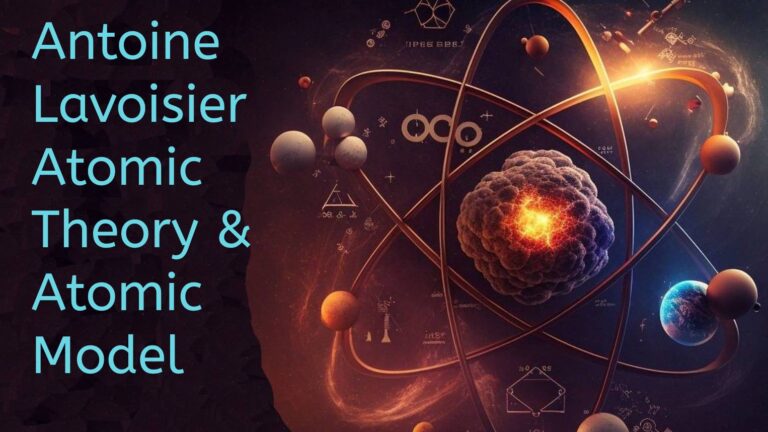Antoine Lavoisier Atomic Theory And Atomic Model played an important role in the development of atomic structure. He was one of the most important scientists in history. Born in Paris, France, on August 26, 1743, he made discoveries that changed how we understand science today, especially chemistry. Many people call him the “Father of Modern Chemistry” because of his many contributions. Let’s explore who he was and what he achieved, focusing on his major role in atomic theory.
Early Life
Lavoisier came from a wealthy family. His father was a lawyer, and his mother left him a large inheritance when she passed away. Though Lavoisier earned a law degree, he was always interested in science, particularly chemistry, astronomy, and botany. Even though his father wanted him to be a lawyer, Lavoisier followed his passion for science and quickly became a member of the French Academy of Science in 1769 at 25.
Antoine Lavoisier’s Scientific Achievements
Lavoisier made many important discoveries that changed how scientists understood the world.
1. Theory of Combustion
Lavoisier was very curious about how things burn. In 1772, he discovered that when phosphorus and sulfur burn in the air, they produce acidic substances. Noticing the products weighed more than the original materials he realized that something from the air was combining with the burning elements. He called this substance oxygen in 1779. Lavoisier showed that oxygen is essential for both burning (combustion) and breathing (respiration). He also found that 20% of the air is made of oxygen, which was a major discovery.
2. Discovery Of Water
Lavoisier also made a huge discovery about water. He named the element hydrogen and found that when it burns in oxygen, it creates water. This disproved the old belief that water was an element on its own. He showed that water is actually a compound made of hydrogen and oxygen.
3. Antoine Lavoisier Law of Conservation of Mass
One of Lavoisier’s biggest achievements was proving that matter cannot be created or destroyed. He did this by conducting experiments in sealed containers to ensure that nothing could escape. In one experiment, he heated mercury oxide and found that when it broke down, it released oxygen gas, and the remaining mercury weighed less by the exact amount of oxygen that had been released. This experiment confirmed his theory of the conservation of mass — that the total weight of materials before a chemical reaction is equal to the total weight afterward.
Antoine Lavoisier’s Contribution to Atomic Theory
Lavoisier played a key role in shaping the atomic theory, which helps us understand the smallest building blocks of matter, called Atoms. Before Lavoisier, people believed that everything was made up of four elements: earth, water, air, and fire.
Modern Atomic Theory
Lavoisier changed this view by showing that these were not elements at all. Instead, he introduced the idea that elements are substances that cannot be broken down further by chemical means. His work laid the foundation for the modern atomic theory, which explains that all matter is made up of small particles called atoms.
Through his experiments, Lavoisier proved that elements like oxygen, hydrogen, and sulfur are real substances that cannot be split into simpler parts. This was a groundbreaking discovery and helped scientists understand that chemical reactions are simply the rearrangement of these tiny atoms without creating or destroying them. His work on the conservation of mass also supported the idea that atoms remain constant during reactions — they just change how they are grouped.
Other Contributions: Chemical Nomenclature
Lavoisier also worked to make the names of chemicals easier to understand. In the late 1700s, there was no clear system for naming substances, so he helped create one. He listed 55 elements that couldn’t be broken down into simpler substances. He also introduced rules for naming acids and salts. For example, acids with more oxygen would end in -ic, like phosphoric acid, while those with less oxygen would end in -ous, like phosphorous acid. This naming system helped scientists communicate clearly about the substances they were studying.
Interesting Facts About Lavoisier
- Lavoisier’s name is one of 52 scientists inscribed on the Eiffel Tower.
- Though he earned a law degree, he never worked as a lawyer.
- He worked on improving street lighting, purifying water, and studying the effects of gunpowder on air quality.
- He also invented the Gasometer, an instrument used to measure gases.
A Tragic End
Despite all his contributions to science, Lavoisier’s life ended tragically. During the French Revolution, his involvement with the government led to his execution by guillotine in 1794. His death was a great loss to the scientific community. One of his friends, the famous mathematician Joseph-Louis Lagrange, said, “It took them only a moment to cut off that head, but a hundred years may not produce another like it.”
Antoine Lavoisier Accomplishments
Antoine Lavoisier’s discoveries changed the world of science forever. His contributions to the understanding of combustion, water, and the conservation of mass helped lay the groundwork for modern chemistry and atomic theory. Today, his work continues to influence scientists and remains a fundamental part of chemistry and science education.

